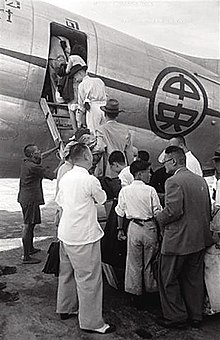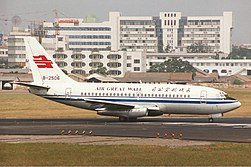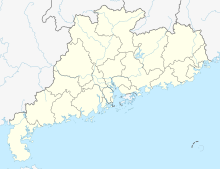Guangzhou Baiyun International Airport (1933–2004)
Guangzhou Baiyun International Airport | |||||||||||
|---|---|---|---|---|---|---|---|---|---|---|---|
 | |||||||||||
| Summary | |||||||||||
| Airport type | Defunct | ||||||||||
| Operator | Guangzhou Baiyun International Airport Co. Ltd. | ||||||||||
| Serves | Pearl River Delta | ||||||||||
| Location | Baiyun, Guangzhou, Guangdong, China | ||||||||||
| Opened | 1933 | ||||||||||
| Closed | 5 August 2004 | ||||||||||
| Hub for |
| ||||||||||
| Elevation AMSL | 1 m / 2 ft | ||||||||||
| Coordinates | 23°11′14″N 113°16′5″E / 23.18722°N 113.26806°E | ||||||||||
| Map | |||||||||||
 | |||||||||||
| Runways | |||||||||||
| |||||||||||
| Guangzhou Baiyun International Airport | |||||||||||
|---|---|---|---|---|---|---|---|---|---|---|---|
| Simplified Chinese | 广州白云国际机场 | ||||||||||
| Traditional Chinese | 廣州白雲國際機場 | ||||||||||
| |||||||||||
Guangzhou Baiyun International Airport (IATA: CAN, ICAO: ZGGG), formerly known as Canton Civil Airport or Pai Yuen Airport, was an airport that served Guangzhou, the capital of South Central China's Guangdong province. Originally opened in 1933, it was one of the first civil airports in China, but was closed on 5 August 2004 when all services were transferred to the new airport of the same name, 23 kilometres (14 mi) to the north.
History
The airport started construction in 1932 and opened in November 1933.[1] During the Canton Operation, the Japanese Navy invaded the airport and expanded the runway.[2] In 1963, the People's Liberation Army Air Force moved away from the airport, making the airport only for public use. The name of the airport is changed to "Baiyun" named from nearby Baiyun Mountain ("Baiyun" in Chinese means "white cloud").[3]
From 1964 to 1967, it underwent a comprehensive expansion, adding an area of 725,300 square meters (7,807,000 sq ft), and extending the runway to 2,500 meters (8,202 ft 1 in) from 2,000 meters (6,561 ft 8 in) before it had the conditions of further navigation with foreign countries.

In the 1980s, the airport renovated and expanded facilities such as oil storage depots, aprons, terminal buildings, boarding bridges, and maintenance hangars to meet the standards of international first-class airports. After the Reform and Opening-up, Baiyun Airport had developed rapidly. Its passenger capacity, takeoffs and landings had ranked first in mainland China for eight consecutive years. After several expansions, it was still far from meeting its demand. It was imperative to choose a new location to build a new airport.
In 1992, the airport underwent civil aviation system reform, and the airport operated as an independent economic entity.
By 2002, the passenger throughput of the old Guangzhou Baiyun International Airport had reached 16,014,400 passengers, and the cargo and mail throughput reached 592,600 tons.
Due to the expansion of Guangzhou, the airport was surrounded by high-rise buildings and was unable to expand further to meet passengers’ needs. Instead, the new Baiyun airport was built and opened on 5 August 2004, and the old airport was closed.[4]
Former airlines and destinations
There are often ferry international flights to Hong Kong, even before its economic open up. Similar to its new airport, it had served a variety of domestic or foreign international airlines back in the 1980s and 1990s such as Pakistan International Airlines, Garuda Indonesia,[5] Air France,[6] Japan Air System, Japan Airlines, All Nippon Airways, Malaysia Airlines, Cathay Pacific, Lufthansa, Philippine Airlines, Thai Airways International, Dragonair, Singapore Airlines, Aeroflot, Baikal Airlines, Royal Air Cambodge, and nearly every domestic airlines.[7][8]

Legacy
The former terminal of the airport is being converted into a large shopping mall. The northern portion of the former airport is being turned into a provincial- and city-level functional area integrating conference services. The southern portion will be converted into Guangzhou's secondary center integrating retail, sports facilities, business, and cultural activities.[9]



Incidents and accidents
- On the 24 December 1982, CAAC Flight 2311, an Ilyushin Il-18B was destroyed by fire after landing at the airport. Twenty-five of the 69 people on board were killed.
- On 2 October 1990, Xiamen Airlines Flight 8301, a Boeing 737-247, was hijacked on route to Guangzhou from Xiamen. While landing at the airport, it sideswiped a parked China Southwest Airlines Boeing 707-3J6B, and crashed into a taxiing China Southern Airlines Boeing 757-21B; of the total 225 occupants involving the aircraft, 97 survived.

See also
- List of defunct international airports
- List of airports in Guangdong province, from 1911-current (Zh-Wiki)
References
- ^ "第一代航站楼:见证广州民航事业的发展" (in Chinese (China)). byss.by.gov.cn. 2017-03-03. Archived from the original on 2018-07-07. Retrieved 2018-07-07.
- ^ "老白云机场的轨迹" (in Chinese (China)). Yangcheng Evening News. 2016-08-13. Archived from the original on 2018-07-07. Retrieved 2018-07-07.
- ^ "广州白云国际机场的历史". travel.sina.com.cn (in Chinese (China)). 2008-08-19. Retrieved 2020-06-27.
- ^ "见证"十五":建新机场十月夷平五座山" (in Chinese (China)). news.southcn.com. 2006-02-12. Archived from the original on 2018-07-08. Retrieved 2018-07-09.
- ^ "Aviation Photo Search". Airliners.net. Retrieved 2021-09-07.
- ^ "Aviation Photo Search". Airliners.net. Retrieved 2021-09-07.
- ^ 梵枫. "十六年前的今天,广州老白云机场关闭_哔哩哔哩_bilibili". www.bilibili.com. Retrieved 2021-11-09.
- ^ "World Routes 25: 2018 Host Guangzhou Network in Nov 1995". Routes. Retrieved 2021-12-18.
- ^ "Baiyun New Town: G5 Mall & Largest Graffiti in Asia GDNews www.newsgd.com". newsgd.com. Retrieved 31 October 2015.

